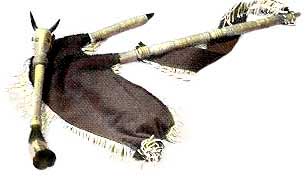- Volynka
Infobox Instrument
name=Volynka
names=HS#:421.111-12

classification=
*Bagpiping Hornbostel-Sachs classification number= 421.111-12
related=
*Bock (Czech)
*Cimpoi (Romanian)
*Duda (Hungarian/Polish)
*Koza (Polish)
*Diple (Dalmatian Coast )
*Tulum (Turkish and Pontic)
*Tsambouna (Dodecanese and Cyclades)
*Askomandoura (Crete)
*Gajdy (Polish/Czech/Slovak)
*Gaita (Galician)
*Surle (Serbian/Croatian)
*Mezoued/Zukra (Northern Africa)
* Guda, tulum(Laz people )
* Dankiyo, zimpona (Pontic )
*Parkapzuk (Armenia )
*Gudastviri (Georgia (country) )
* Tsimboni (Georgia (country) )(Adjara )
* Shuvyr (Circassians )
* Sahbr, Shapar (Chuvashia )
* Tulug (Azerbaijan )
*Gaida (South Eastern Europe ) (the Balkans )The Volynka ( _uk. Волинка), ( _ru. Волынка),( _cr. Tulup zurna) - see also
Duda ,Koza , andKobza )It is a Slavic bagpipe. Its etymology comes from the region where it was probably invented -Volyn ,Ukraine .The "volynka" is constructed around a
goat skin air reservoir into which air is blown through a pipe with a valve to stop air escaping. (Modern concert instruments often have a reservoir made from a basketball bladder}. A number of playing pipes [two to four] extend from the reservoir holding the air. The main playing pipe on which the melody is played has five to seven, sometimes eight finger holes. The other pipes produce a drone. This is usually either a single tonic note or a perfect fifth. Each of these playing pipes has a double reed usually made from agoose quill . In the 20th century this instrument has lost the popularity it had previously, and is rarely used today in an authentic context.Modern usage
The instrument has gained popularity in stage performance. It has been used in a number of songs by
Russian rock bands DDT, Aquarium, and Aria. It also appears more in Russian folk music andUkrainian folk music ensembles.Related instruments
The Volynka has many cousins, some of which can be found here. Some of these related instruments are:
*Bock (Czech)
*Cimpoi (Romanian)
*Duda (Hungarian/Polish)
*Koza (Polish)
*Diple (Dalmatian Coast )
*Tulum (Turkish and Pontic)
*Tsambouna (Dodecanese and Cyclades)
*Askambandoura (Crete)
*Gajdy (Polish/Czech/Slovak)
*Gaita (Galician)
*Surle (Serbian/Croatian)
*Mezoued/Zukra (Northern Africa)
* Guda, tulum(Laz people )
* Dankiyo, zimpona (Pontic )
* Parakapzuk (Armenia )
* Gudastvri (Georgia (country) )
* Tsimboni (Georgia (country) )(Adjara )
* Shuvyr (Circassians )
* Sahbr, Shapar (Chuvashia )
* Tulug (Azerbaijan )
* Gaida (South Eastern Europe ) (the Balkans )ources
*Humeniuk, A. - Ukrainski narodni muzychni instrumenty - Kyiv: Naukova dumka, 1967
*Mizynec, V. - Ukrainian Folk Instruments - Melbourne: Bayda books, 1984
*Cherkasky, L. - Ukrainski narodni muzychni instrumenty // Tekhnika, Kyiv, Ukraine, 2003 - 262 pages. ISBN 966-575-111-5
Wikimedia Foundation. 2010.
